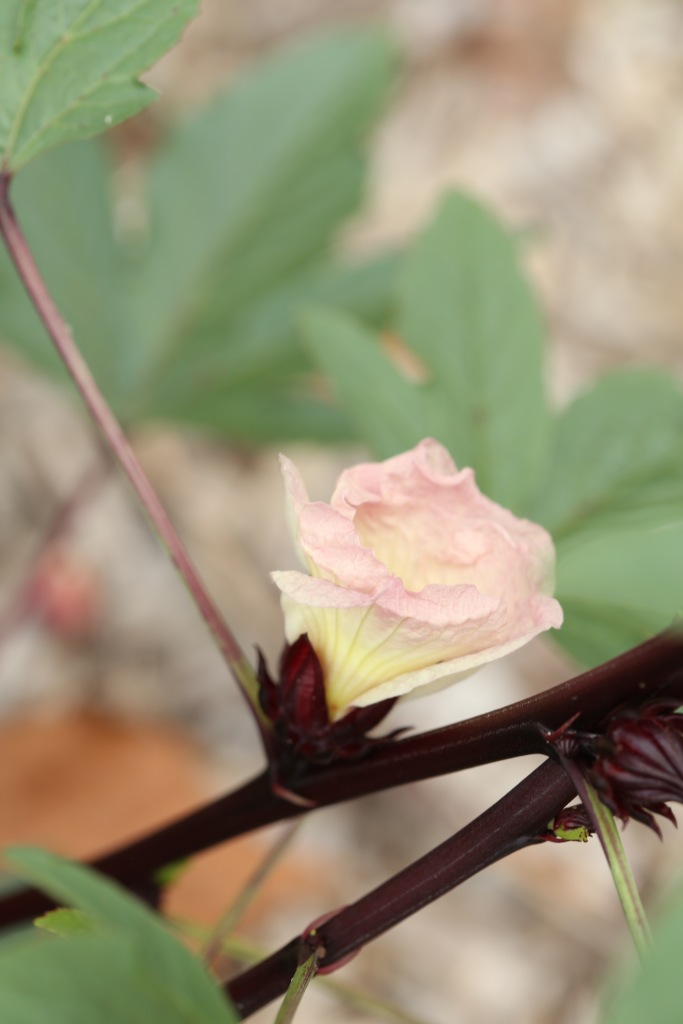 Isn’t it wonderful when several of your favorite things come together? Everyone who visits this blog knows I love to garden and that baking is what I do professionally. But I am betting that not many of you know that I have a thing for hibiscus plants, specifically, Hibiscus sabdariffa. More commonly known as Roselle, this is the variety of hibiscus used to make tea. Just look at that bloom; how could you not love it?
Isn’t it wonderful when several of your favorite things come together? Everyone who visits this blog knows I love to garden and that baking is what I do professionally. But I am betting that not many of you know that I have a thing for hibiscus plants, specifically, Hibiscus sabdariffa. More commonly known as Roselle, this is the variety of hibiscus used to make tea. Just look at that bloom; how could you not love it?
 While the flower is pretty, and edible, it is a day flower which means it opens for a day and then dies. As soon as the bloom withers, the plant begins producing seeds in the calyx. To make tea, you must gather them before the pod swells with immature seeds. It takes quite a few to make a pot of tea! Because of this, I generally plant 3 or 4 of them around the garden and yard. They can get quite large if the conditions are right; lots of direct sun, plenty of moisture but not soggy.
While the flower is pretty, and edible, it is a day flower which means it opens for a day and then dies. As soon as the bloom withers, the plant begins producing seeds in the calyx. To make tea, you must gather them before the pod swells with immature seeds. It takes quite a few to make a pot of tea! Because of this, I generally plant 3 or 4 of them around the garden and yard. They can get quite large if the conditions are right; lots of direct sun, plenty of moisture but not soggy.
 If you are looking at this plant and are thinking that it looks like okra, you are right! Hibiscus is also related to cotton and if you spend time in garden centers, you will find that there are lots of perennial and annual varieties of hibiscus. Unfortunately, this variety will not survive a freeze which means you must overwinter it indoors or start over each spring which is what I do. The seeds need heat and will not germinate until the soil is warm. Start them indoors or wait until about May to plant seeds outdoors.
If you are looking at this plant and are thinking that it looks like okra, you are right! Hibiscus is also related to cotton and if you spend time in garden centers, you will find that there are lots of perennial and annual varieties of hibiscus. Unfortunately, this variety will not survive a freeze which means you must overwinter it indoors or start over each spring which is what I do. The seeds need heat and will not germinate until the soil is warm. Start them indoors or wait until about May to plant seeds outdoors.
 They will begin blooming in late summer and that is when you will have calyxes to collect. Spread them out and dry them completely, I do it in the oven with just the light on. Then when dry, you can store them in a glass jar.
They will begin blooming in late summer and that is when you will have calyxes to collect. Spread them out and dry them completely, I do it in the oven with just the light on. Then when dry, you can store them in a glass jar.
 So what does this plant have to do with baking? This week’s recipe from Baking Chez Moi calls for hibiscus tea! This recipe mixed up quickly and easily and when it was all said and done, I sent these, along with the Valentine’s Share-A-Heart cookies to my girls for Valentine’s Day. They loved them!
So what does this plant have to do with baking? This week’s recipe from Baking Chez Moi calls for hibiscus tea! This recipe mixed up quickly and easily and when it was all said and done, I sent these, along with the Valentine’s Share-A-Heart cookies to my girls for Valentine’s Day. They loved them!
 Devon called hers a little pink pizza and looking at that shot, I can see why. However, they tasted like no pizza I have ever eaten! Crispy and flaky and full of vanilla(I was out of rose water) and with just a hint of tangy, floral notes from the hibiscus tea.
Devon called hers a little pink pizza and looking at that shot, I can see why. However, they tasted like no pizza I have ever eaten! Crispy and flaky and full of vanilla(I was out of rose water) and with just a hint of tangy, floral notes from the hibiscus tea.
 The recipe does not call for much tea so I only used a few calyxes-whizzed them in the spice grinder. My thought is that next time, and there will be a next time, I will use double the amount. After all, summer is coming and I will have more plants in the garden!
The recipe does not call for much tea so I only used a few calyxes-whizzed them in the spice grinder. My thought is that next time, and there will be a next time, I will use double the amount. After all, summer is coming and I will have more plants in the garden!
 Join us sometime! We love the company. Pick up a copy of Baking Chez Moi and bake along with us. To see how the rest of the bakers did, visit the website.
Join us sometime! We love the company. Pick up a copy of Baking Chez Moi and bake along with us. To see how the rest of the bakers did, visit the website.



